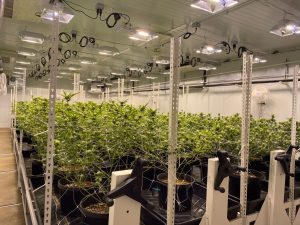Behind the Panels: Commercial Grow Room Design
You made the sustainable choice to retrofit an existing space, but now you’ve got mold and mildew in your commercial grow room? Not every grow room design material is cut out for long-term protection.
Lyndsey Shaw, Chief Operations Officer at Brighterside Vertical Farms, is a commercial grow room design expert. One of the founders of Brighterside Vertical Farms with over 15 years of experience cultivating, Lyndsey is a go-to industry authority in cultivation technology, vertical farming practices, and grow room design.
Brighterside Vertical Farms originally focused on crafting standard operating procedures for growers looking to expand to industrial settings. Over time, they noticed a hole in the market for commercial grade growing equipment and created their own industrial growing vertical farming systems.
Grab a cup of coffee, sit down, and check out this interview with Lyndsey for an inside look from a leading industry cultivation consultant, grower, and facility designer. For the full-length interview, follow the link below.
Vertical Farming with Brighterside Vertical Farms
MU: Lindsey, what are some of the reasons that Brighterside Vertical Farms continues to use PermaTherm as you grow and expand?
Lyndsey Shaw: I would say using PermaTherm, and continuing to use PermaTherm, is an easy decision because the product is so effortless. It’s easy to put together, it’s clean. We love to say that PermaTherm gives us a neutral space every single time. We cultivate in these rooms and refresh the room when the [growing] cycle is done, and I love the fact that PermaTherm products enable us to have a clean slate every time.
There are no microbials that grow on the panels. We’re able to keep our climate control at a neutral temperature using CO2, we’re able to have a seal-proof room. So, all these things add to why we continue to use PermaTherm versus traditional construction materials.
Jeff Bennet, PermaTherm Consultant: What I find within the growing space is that with licensing, permitting, anything like that – it usually happens very quickly. Once you get your CO, it’s like “let’s go, let’s go now, how do we get up and growing immediately?” To me, that’s the nice thing about providing a solution – just how quickly you can put up a hermetically sealed environment.
Lyndsey Shaw: Oh, it’s amazing. And it’s fun for us, too. We work with several different construction companies all over the country. When we’re in New Jersey, we work with New Jersey companies, in Pennsylvania, we work with Pennsylvania companies, Detroit, Colorado…so it’s been fun to turn construction companies on to PermaTherm’s insulated metal panel products. They’re a little hesitant sometimes and say things like “I don’t know how to put this product together,” I reassure them and say, “Listen, I have physically myself built a room out of PermaTherm panels.” It’s so easy to use that I can’t say enough about it.
 Some of the contractors we work with, now that they’ve experienced using PermaTherm products, they’re sold. It’s become a no-brainer for them when they’re transitioning into a new job. They say, “Okay, well we’re using PermaTherm, that’s checked and done.”
Some of the contractors we work with, now that they’ve experienced using PermaTherm products, they’re sold. It’s become a no-brainer for them when they’re transitioning into a new job. They say, “Okay, well we’re using PermaTherm, that’s checked and done.”
MU: Because we hit on sustainability a little bit earlier, what have you noticed with energy and efficiency with your build-out?
Lyndsey Shaw: A couple of things we’ve noticed are that the environment holds better. If we want the environment to be at 68° or 72° – something in that range – it really does hold longer.
Essentially, we’re building a cooler. That’s the type of technology we’re using. Furthermore, when it comes to CO2 and introducing CO2 into our grow: CO2 is very expensive. Having a seal-proof room that enables us to pump CO2 into the rooms is great. Holding the environment temperature, enabling us to pump the rooms with CO2, and not have loss from a cost perspective – that’s really where we see the advantages.
Then, from a microbial standpoint, at the end of each cultivation we can hit it with a hose, clean it, and it’s done. There’s no mold growth, mildew, or anything like that. That’s been great, because I know in a lot of the retrofitted buildings that we’ve built equipment into that weren’t using PermaTherm panels, they’re constantly dealing with mold production on drywall, and that is not sustainable.
For an insider look into construction practices and tips for indoor growing, check out the full-length interview.
For more on PermaTherm panels for indoor growing, click here.

Recent Comments